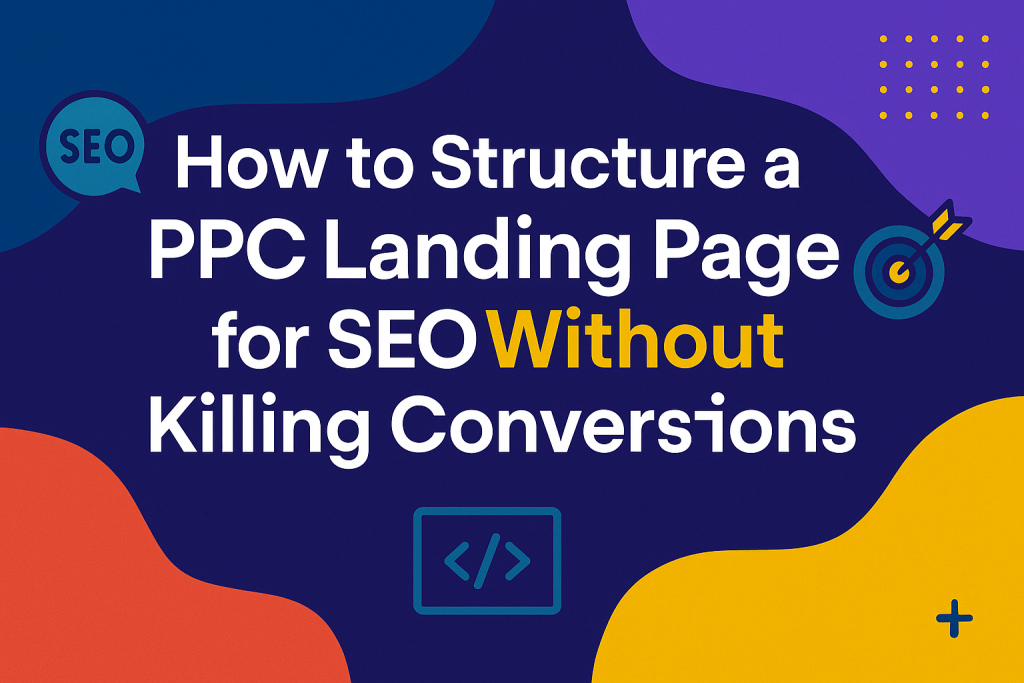
SEO and CRO Can Work Together — If You Structure Your PPC Landing Page Right
When building a PPC landing page, most marketers face a tradeoff:
- Do I optimize this page for Google Ads conversions?
- Or do I structure it for SEO visibility?
Truth is, you don’t have to choose. You just have to be intentional.
“Conversion happens on the page. Visibility starts before the click.”
— Ad Loft
In this guide, we’ll show you how to build SEO-friendly PPC landing pages that don’t kill your conversion rate. For more detailed help, explore our Landing Page Design and Google Ads Management services.
Why SEO and CRO Usually Clash on Landing Pages
1. SEO Requires Content. CRO Requires Focus.
SEO says: Add more content.
CRO says: Cut distractions.
Balance point: Layer content with toggles, tabs, or expandable FAQs. Use visual hierarchy to guide readers who skim.
2. SEO Needs Crawlability. PPC Needs Speed.
SEOs want HTML-based content, schema, and internal linking.
CRO wants minimal load time.
Balance point: Use semantic HTML and avoid JS-heavy page builders. Our landing page audit checklist can help you spot performance-killing structures. Tools like GenerateBlocks or custom builds work better than bloated page builders.
3. SEO Loves Internal Links. CRO Hates Exit Paths.
Linking to your services and case studies is great for SEO. But CRO says, “One goal per page.”
Balance point: Place contextual links near the footer or in optional expandable content blocks.
What Makes a Landing Page Crawlable (and Still Convert)
If you’re running Google Ads and want long-term SEO benefits, your page must:
- Be indexable (not blocked by robots.txt or meta tags)
- Use fast-loading, semantic HTML
- Include schema markup (FAQPage, Article, WebPage)
- Contain relevant keywords like “landing page SEO” and “PPC landing page structure”
- Use alt text and headings that describe your offer clearly
- Link internally to relevant pages without distracting from the CTA
Example Structure: SEO-Friendly PPC Landing Page
Here’s a proven layout that supports both performance and visibility:
🔎 Above the Fold
- Headline with search intent match (e.g., “Get a Free Case Review”)
- Subheadline clarifying value
- CTA button
- Trust badges or ratings
🌐 SEO-Focused Supporting Content
- Keyword-targeted paragraph (e.g., “We offer Google Ads landing page optimization for law firms across LA…”)
- Image with descriptive alt text
- Expandable FAQ or “What to Expect” section with internal links
⚡ Social Proof Section
- Testimonials or reviews
- Logo strip of past clients or case studies
🏋️ CTA Section (Repeated)
- Reinforce benefit + another CTA
“You don’t need a long page. You need the right content in the right places.”
— Ad Loft
Real-World Application: Cross-Industry Takeaways
Even though every industry has unique needs, the fundamentals of SEO and CRO co-optimization stay consistent. Here’s what we’ve learned from optimizing hundreds of campaigns:
🔍 Service-Based Businesses
- Focus on location-based relevance and trust signals
- Use FAQ schema to handle user objections in a crawlable way
- Mobile-first layouts with clear tap-to-call CTAs win conversions. See our cleaning service case study for a real-world example.
🛒 eCommerce & DTC Brands
- Keep product pages fast and focused
- Layer SEO content under product benefits using tabs or collapsible blocks
- Use Product schema for visibility in AI Overviews. Our eCommerce PPC case study breaks down this approach in action.
🧠 Professional Services & High-CPC Verticals
- Prioritize intent-matching headlines and testimonial sections
- Don’t overload above the fold — keep it clean, then expand below
- Pair custom-built landing pages with targeted PPC + SEO efforts for best ROI. For legal-specific results, check out our law firm Google Ads strategy.
Whether you’re selling services, physical products, or expert consultations, structuring your landing page for crawlability and conversions is no longer optional. It’s how smart brands scale.
Tools That Help You Build SEO + CRO Friendly Pages
- Unbounce – Use for testing, but avoid JS-heavy themes
- Instapage – Good for scaling templates, not for SEO
- Custom HTML/CSS – Best balance of crawlability and speed
- GenerateBlocks + GeneratePress – Lightweight WordPress framework ideal for this hybrid approach
Pro Tips for SEO & CRO Coexistence
1. Responsive Typography with clamp()
Use clamp() in your CSS to create scalable, fluid typography that looks great on mobile, tablet, and desktop. This improves readability and user experience across devices.
2. Keep Above-the-Fold Clean
Don’t clutter the top of your landing page with too much content. Prioritize your headline, subhead, and CTA, then layer SEO content further down the page.
3. Strategically Place Internal Links
Add internal links in non-intrusive areas like expandable FAQs or at the bottom of the page. This helps search engines understand your content without hurting conversions.
4. Include Structured Schema Markup
Use FAQPage, HowTo, Breadcrumb, and WebPage schema to improve your visibility in AI Overviews, voice search, and featured snippets.
Frequently Asked Questions
What is a crawlable landing page?
A crawlable landing page is indexable by search engines and uses semantic HTML, text-based content, and schema.
Can I rank a PPC landing page in Google?
Yes, if it’s structured for SEO and not blocked from indexing. Many service pages double as both.
How much content should I add to a PPC landing page?
Enough to explain the offer, build trust, and match the user’s search intent. Use expandable content for SEO.
Will SEO hurt my conversion rate?
Not if it’s done strategically. Keep conversion-focused content visible, and SEO content structured.
Should I avoid internal links on landing pages?
No, just place them where they won’t distract from your CTA—footer, FAQs, or post-submit.
Ready to convert and rank? Build your next page with both search visibility and user conversion in mind.

